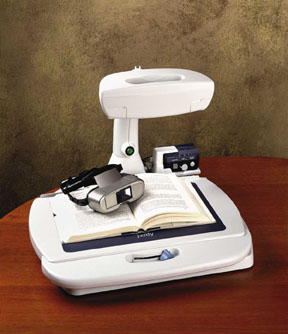
Improving Vision
Many people are familiar with the popular science fiction series Star Trek: The Next Generation, a show featuring a blind character named Geordi La Forge, whose visor-like glasses enable him to see. What many people do not know is that a product very similar to Geordi's glasses is available to assist people with vision conditions, and a NASA engineer's expertise contributed to its development.
The JORDY™ (Joint Optical Reflective Display) device, designed and manufactured by a privately-held medical device company known as Enhanced Vision, enables people with low vision to read, write, and watch television. Low vision, which includes macular degeneration, diabetic retinopathy, and glaucoma, describes eyesight that is 20/70 or worse, and cannot be fully corrected with conventional glasses.
Unlike someone who is blind, a person with low vision retains a small part of his or her useful sight. JORDY enables people to see using their remaining sight by magnifying objects up to 50 times and allowing them to change contrast, brightness, and display modes, depending on what works best for their low vision condition. With this device, people can see objects at any range, from up close to distant. It also provides the flexibility for the user to enjoy theatre, sporting events, and more. JORDY functions as a portable display that is worn like a pair of glasses and as a fully functional desktop video magnifier when placed on a docking stand.
JORDY was inspired by the Low Vision Enhancement System (LVES), a video headset developed through a joint research project between NASA's Stennis Space Center, Johns Hopkins University, and the U.S. Department of Veterans Affairs. Worn like a pair of goggles, LVES contained two eye-level cameras, one with an unmagnified wide-angle view and one with magnification capabilities. The system manipulated the camera images to compensate for a persons low vision limitations. Although the technology was licensed and marketed by Visionics Corporation, LVES was only commercially available for a short time.
In an effort to bring a new and improved low vision headset to the market, Enhanced Vision, of Huntington Beach, California, pursued the development of JORDY. With advances in smaller camera technology, the company significantly increased the head-worn video magnifiers usability, effectiveness, and overall portability. Paul Mogan, an engineer at NASA's Kennedy Space Center, has enthusiastically helped Enhanced Visions' continuing efforts to improve JORDY by contributing ideas and evaluating prototypes.
Legally blind since age 19 due to macular degeneration, Mogan began using the JORDY 1 in 1999. With suggestions for improving the product, he began corresponding with Enhanced Vision. For example, because slight head movements while wearing JORDY would cause the image to jump, Mogan recommended adding image stabilization to the product. He found the company happy to receive and implement his feedback. When Enhanced Vision developed JORDY 2, a lighter, smaller version of the original device, Mogan again offered suggestions for refinements. One of the enhancements noted for JORDY 3 incorporates an even smaller, high-resolution camera that fits into small, discreet glasses that weigh less than 2 ounces. Increased miniaturization will allow Mogan and others to wear JORDY comfortably for longer periods of time.
JORDY significantly improves the lives of people with low vision by enabling them to pursue their goals. According to Mogan, "As an engineer, I'm always looking for the technologies that are going to give me the edge to keep up. The JORDY has done this more than anything else on the market." He particularly benefits from the product at work whenever he reads for extended periods of time or completes forms. By placing JORDY on a docking stand above a book, Mogan reads magnified pages that are projected onto his computer screen.
Aside from assisting at work, JORDY helps people regain their independence in other ways. The device, when plugged directly into a television set and used in combination with the headset, allows the visually impaired to enjoy television. JORDY also enables people to participate in events, and to see the faces of family and friends. For example, when U.S. speedskater Casey FitzRandolph won a gold medal in the 2002 Winter Olympic Games, his grandfather was able to watch the historic moment from the stands using his JORDY.
An eye care professional or low vision specialist can best determine JORDY"s suitability for a patient's individual condition during a routine eye exam. Enhanced Vision works with leading doctors throughout the United States and Canada. Its products are available in over 70 countries worldwide.
JORDY™ is a trademark of Enhanced Vision.

By placing JORDY™ on a docking stand above a book, a person with low vision can read magnified pages that are projected onto a computer screen.

The JORDY™ headset, when worn like a pair of glasses, enables people with low vision to see objects at any range.













